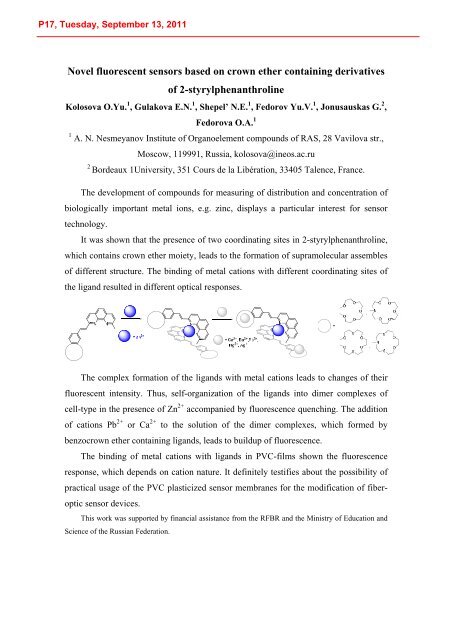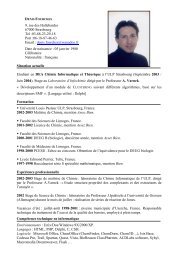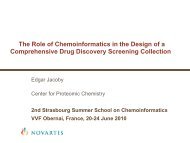International Summer School PROGRAM - Laboratoire d'Infochimie ...
International Summer School PROGRAM - Laboratoire d'Infochimie ...
International Summer School PROGRAM - Laboratoire d'Infochimie ...
Create successful ePaper yourself
Turn your PDF publications into a flip-book with our unique Google optimized e-Paper software.
Novel fluorescent sensors based on crown ether containing derivatives<br />
of 2-styrylphenanthroline<br />
Kolosova O.Yu. 1 , Gulakova E.N. 1 , Shepel’ N.E. 1 , Fedorov Yu.V. 1 , Jonusauskas G. 2 ,<br />
Fedorova O.A. 1<br />
1<br />
A. N. Nesmeyanov Institute of Organoelement compounds of RAS, 28 Vavilova str.,<br />
Moscow, 119991, Russia, kolosova@ineos.ac.ru<br />
2<br />
Bordeaux 1University, 351 Cours de la Libération, 33405 Talence, France.<br />
The development of compounds for measuring of distribution and concentration of<br />
biologically important metal ions, e.g. zinc, displays a particular interest for sensor<br />
technology.<br />
It was shown that the presence of two coordinating sites in 2-styrylphenanthroline,<br />
which contains crown ether moiety, leads to the formation of supramolecular assembles<br />
of different structure. The binding of metal cations with different coordinating sites of<br />
the ligand resulted in different optical responses.<br />
The complex formation of the ligands with metal cations leads to changes of their<br />
fluorescent intensity. Thus, self-organization of the ligands into dimer complexes of<br />
cell-type in the presence of Zn 2+ accompanied by fluorescence quenching. The addition<br />
of cations Pb 2+ or Ca 2+ to the solution of the dimer complexes, which formed by<br />
benzocrown ether containing ligands, leads to buildup of fluorescence.<br />
The binding of metal cations with ligands in PVC-films shown the fluorescence<br />
response, which depends on cation nature. It definitely testifies about the possibility of<br />
practical usage of the PVC plasticized sensor membranes for the modification of fiberoptic<br />
sensor devices.<br />
This work was supported by financial assistance from the RFBR and the Ministry of Education and<br />
Science of the Russian Federation.









